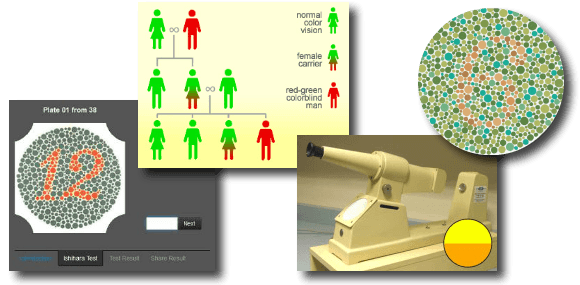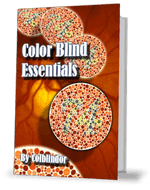Color blindness (or colour blindness — or more specific color vision deficiency (CVD)) is well known but hard to imagine if you are not suffering from it. So usually people are either looking for more information to learn about color blindness and all its details, would like to better understand the vision by simulating it or want to test themselves with some form of color blindness test. All this you can be found here on color-blindness.com — and much more.
Color blindness affects approximately every 1 in 12 men (8%) and 1 in 200 women (0.5%). This means there is definitely one in your neighborhood or school class affected by it. Most of them are male, because the most common form called red-green color blindness (a term wich is also misleading) is encoded on the x-chromosome and therefore sex-linked. As red-green color blindness is inherited from a mother to her son, a father never passes this type of color blindness on to his male children.
Free color blindness test app: Color Blind Check
The term red-green color blindness is often used but actually not quite correct. Ever type of color vision deficiency affects the whole color spectrum and therefore can not be reduced to just certain colors. Of course, for the most often encountered types Protanomly (the milder form or red-weakness) or Protanopia (missing red cones, red-blindness) and Deuteranomaly (green-weakness) or Deuteranopia (green-blindness) the colors red and green are the most problematic and misinterpreted or indistinguishable ones. But people suffering from any of those forms have issues with the red or green part in every color, so the whole spectrum of colors is affected.
Free eBook: Color Blind Essentials
Besides red-green color blindness, which is encoded on the x-chromosome (sex-linked) and therefore much more common for men, there are also forms of color vision deficiency which are evenly distributed between male and female like Tritanomaly (blue-weakness) or Tritanopia (blue-blindness) and the real color blindness Achromatopsia (monochromacy) or the so called blue-cone monochromacy (only blue cones).
Color blindness simulation is fascinating! If you are not colorblind it is so hard to imagine what it looks like to be colorblind: Which color do you see? Do you see any at all? What does it mean not to be able to see red? and so on. My COlor BLIndness Simulator is a handy tool which allows you to use your own images and try out all the different simulation types. It is even possible to save any simulated image and have a one-by-one comparison.
Online color blindness testing is often done but unfortunately no yet as good as it could be. Usually you’ll find out about color blindness at school or when visiting an eye specialist and want to confirm this with some online tools. There are online color blindness tests available, but most of them are not reliable and cannot compensate a visit at your eye specialist. There is a new form of color blindness test coming up: Color Blind Check uses a new method and its results look very promising. But this new form still needs more time to develop and calibration to count as a trustable color blindness test.


